#duchess of suffolk
Text

Happy Tudor Tuesday from their Graces the Duke and Duchess of Suffolk ♥️
(Art by 1Enary1 on Deviantart)
#henry cavill#charles brandon#duke of suffolk#the tudors#tudors#all man#duchess of suffolk#the duke and duchess of suffolk#henry cavill art#beautiful art#alternative charles#bearded duke#bearded brandon#s4 was the best charles#🌹♥️🌹♥️🌹♥️🌹♥️🌹♥️🌹♥️🌹♥️🌹♥️🌹♥️🌹♥️🌹♥️🌹♥️🌹♥️🌹♥️#their graces#his duchess
20 notes
·
View notes
Text
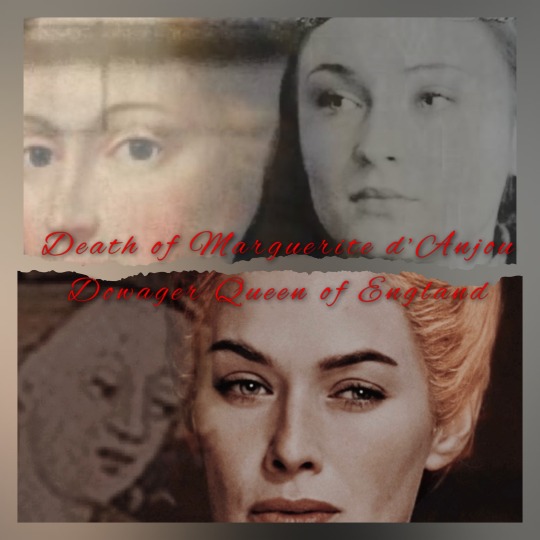
“24 August 1482
From the fairytale turrets of Saumur Castle, atop which golden fleur-de-lys glistened in the summer light, to the bulbous towers of Angers, where the château loomed on a cliff edge above the River Loire, the funeral cortege of Margaret of Anjou carried the queen on her last journey.
For six years she had been exiled back to the lands in which she grew up, a half-welcome guest of her father and King Louis, with little more than hunting dogs, books and a casket of relics to remind her of past glories. She was going now to rejoin her ancestors. Her last request to King Louis was that he would allow her to be buried with her parents: in their sepulchre at Angers Cathedral.
Since her capture at Tewksbury in 1471 Margaret's life had become one of solitary retirement. She had not stayed long in the Tower of London, although she must have been there when Henry was killed.
For a time she was kept at Windsor Castle, and by January 1472 she had moved to Wallingford in Oxfordshire, where her keeper was her old friend, Alice Chaucer, dowager duchess of Suffolk.
The women had once been close, Alice perhaps even having something of a maternal place in Margaret's heart. Since Suffolk's murder their lives had taken very different courses, and their enforced time together during Margaret's imprisonment cannot have been entirely happy.
Where Margaret had resisted the Yorkist regime with all her strength, Alice had come to terms with it even before Henry VI was first deposed. In 1458 Alice had overseen the marriage of her only child, John, to York's daughter Elizabeth. At the time this must have seemed a dangerous move, but her gamble had paid off. Her son still lived, a prominent member of the court of King Edward IV, and a king's brother-in-law.
Margaret, by contrast, had lost her family to the wars. Under house arrest, she was reliant on Edward to provide her with enough money to cover the expenses of herself and her servants.
One of those servants was Lady Katherine Vaux. Katherine had lost her husband, Margaret's old servant Sir William, at Tewksbury and the pair were bound so tightly together, whether through shared grief or the loyalty of many years' service, that Katherine stayed with Margaret until the end.
The pair of them probably appear in an image in the Guild Book of the London Skinners' Fraternity in 1475. Margaret wears an ermine-lined dark gown, her head covered like a nun, kneeling forward to read a religious text from her prayer book while a discarded crown and sceptre lie beside her. Behind Margaret is a more fashionably dressed woman, evidently in attendance on the queen, with her prayer book in her hands, her eyes more on her mistress than her prayers.
Both Katherine and Margaret were members of this fraternity in honour of the Assumption of the Virgin Mary who Margaret, like Henry, always particularly revered. As this image in the Skinners' record suggests, Margaret's imprisonment under Edward IV was not especially stringent.
Other members of the Skinners' Guild Fraternity included Queen Elizabeth Woodville and her ladies, so the fraternity would not have risked their ire by welcoming Margaret without their consent.
Margaret was provided with clothing, mostly black, at royal expense and had enough freedom not only to join this guild but also to enjoy the services of the dean of Edward's chapel in 1474. Having moved from Wallingford to London for most of the intervening years, in 1475 an international treaty between Edward and Louis XI was finalized that ransomed Margaret to Louis for £50,000.
In return for being able to return to her father's territories with a small pension from Louis, Margaret was forced to renounce all of her claims not only in England but also in France. The woman who had clung so tenaciously to her family's right to the English crown was now willing to give up virtually everything she owned to go home. After all, there was no one to inherit her titles or lands after her death. Thus, in November 1475, she was transferred into the keeping of Sir Thomas Montgomery to be escorted to France.
For several years Margaret lived in her father's castle at Reculée, near Angers, but when René died in 1480 she had to rely on one of his servants to provide her literary interests. Some years earlier she had commissioned the Burgundian memoirist Georges Chastellain to write Le Temple de Bocace, a consolation piece dwelling on the changing fortunes of the world and the unjust criticism that had been levelled at her.
Presumably she also occasionally rode or hunted through the verdant rolling fields and woodland surrounding her, enjoying at least one pastime from her old life. Margaret may have ridden from her modest home at Dampierre to the more imposing Château Montsoreau on the banks of the River Loire, over time she developed enough of a relationship with he castle's owner, Madame de Montsoreau, to gift her all of her hunting dogs shortly before her death - a high-status offering for a lady who had perhaps been a friend in the queen's last years.
In the summer heat of 1482 Margaret fell ill and, with the faithful Katherine Vaux at her side, she made her last will and testament on 2 August. Louis XI, who had once mocked her proud writing style, would have found little to displease him in the humble petitions that filled this short document.
'Sound of mind, reason and thought, however weak and feeble of body', Margaret asked to be buried in the cathedral church of St Maurice in Angers beside her parents, 'in whatever manner it pleases the king to ordain, or in another place if he prefers'.
She wrote that she did not have enough money to cover the cost of the funeral and suggested that Louis sold her remaining possessions to pay for her burial - as indeed he did.
And perhaps thinking of Lady Katherine, she 'recommend(ed] very humbly and affectionately' her 'poor servants... to the good grace and charity of the said King'. She had evidently lived on the charity of others for some time, and implored Louis, as her sole heir, to cover any remaining debts she had incurred.
Louis did as Margaret asked and had her honourably buried with her parents, but he insisted on reclaiming the hunting dogs that she had gifted to Madame de Montsoreau. 'You know (Margaret] has made me her heir, the king reminded Montsoreau in a letter written days before the queen actually died, 'and that this is all I shall get; also it is what I love best. I pray you not to keep any back, [or] you would cause me a terribly great displeasure’.
Even in death, Henry and Margaret were the pawns of others.”
JOHNSON, Lauren. “Life and Death of Henry VI”.
Fan cast: Sophie Turner as young Marguerite and Lena Headey as Queen Marguerite.
#margaret of anjou#Marguerite d’Anjou#reine marguerite d'angleterre#queen Marguerite#queen margaret of Anjou#queen margaret#house of lancaster#Plantagenet dynasty#wars of the roses#cousin’s wars#Katherine vaux#Alice chaucer#Edward iv#Elizabeth of York#duchess of Suffolk#Henry VI#king Henry VI#Louis XI of France#Louis XI
19 notes
·
View notes
Text
This is not Catherine Willougby!

Absolutely no way! She was born in 1519(which i previously didn’t know) and this gable hood started to go out of fashion during Holbein’s first stay in 1526/1527. He then returned to England in 1532 and by then it way out of fashion.
Does she look eight to you?! No. That woman is at least 20! For it to be Catherine Willoughby it’d have to be gable hood of style of very late 1530s, with both veils up-not down!
I am hitting my forehead for not realising this sooner. This is 100% misidentified as Catherine Willoughby.
But then who is it? Could it be the woman who actually was Duchess of Suffolk in 1526/7? Let’s try to find out.
The big labels on Holbein’s drawings come from 18th century(on lady Surrey i marked it red), but if I recall correctly, prior to that in mid of 16th century somebody-some courtier labelled these and on some drawings you can still see remains of these-marked in green:

I can’t for love of god recall name of that courtier(I tried to find it, I couldn’t).
But his identification of the people in Holbein’s drawing is not questioned that much, because he lived at court and would actually meet these people.
What is then questioned is if somebody in 18th century then added few labels to those he didn’t mark in 16th century. (Which might have happened.)It’d be now impossible to tell if there were 16th century labels-because pencil can naturally rub off and because there were also sometimes notes done by Holbein regarding the dress, where he described for example colour and material of dress. You can’t then tell if it was Holbein’s text or that courtier’s text-except that that courtier tended to write the label not on the body. But then again, Holbein also sometimes sketched on side some other details.
But generally speaking we trust that courtier’s identification.
So if 18th century text saying Duchess of Suffolk is based upon his 16th century label, then who was duchess of Suffolk in 1526/7?-Mary Tudor, Queen of France
(Which we call Mary Rose to distinguish her from Mary I, who was also Mary Tudor. Even though historically she wasn’t call Mary Rose.)
Certainly we have to consider such possibility.
I’ve done 2 posts about Mary Rose’s depictions and two more about portraits of woman in spanish outfit which turned out to be her. I’ve done a thorough research. I should be able to tell straight away, right? Especially given we’re talking the great beauty and this:
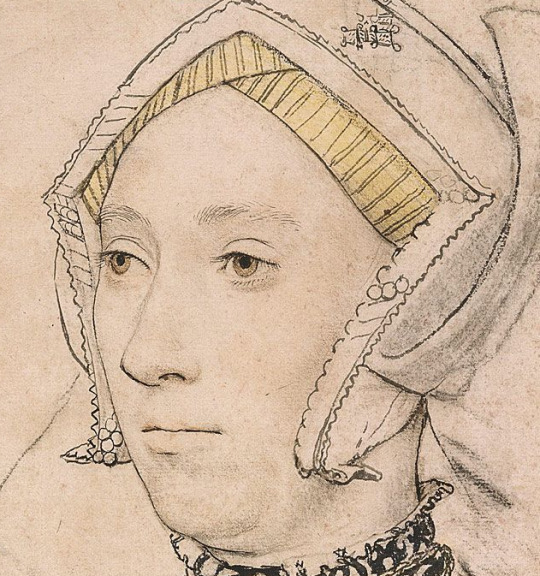
Well, it is not that simple! If you compare the surviving sketches vs finished work of Holbein-then it is clear the sketch is very unflattering and too harsh upon features. It can make person look way less pretty than they were and eyebrows way thicker.
Plus he didn’t shade the face much, only lightly, and over centuries that rubbed off, sometimes not much, but one time so much you can no longer tell what the outfit was like(lady Borrow-that one is completely unusable).
So Holbein’s sketch is not as ideal as the finished painting would be for comparison. But it is still usable, we just need to allow it bigger margin of difference than we would normally.
Straight away I have to clear one thing. In the sketch the eyes are light brown. In contemporary report it says Mary Rose’s eyes were grey.
It was I who then speculated she could had light blue eyes, which could then be mistaken for light grey eyes. But contemporary report said grey. And if we were lazy, we’d say-ok, it can’t be her. The eyes don’t match. Not so fast, my dears.
Are all the eyes in these 4 depictions of Mary Rose grey?

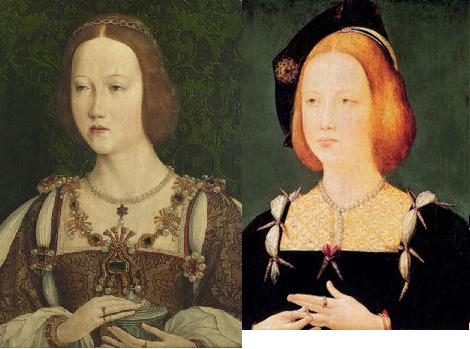
At first glance yes. On second? No.

-grey/brown eyes(hazel)

-dark grey or dark grey-brown?

-this one i could only find in HD on reproduction which is very yellow. Looks like lighter grey to me, but we cannot be certain

-light hazel towards grey and brown, with bits of yellow in middle)
Probably this:


Or this:

Or something in between.
These real eyes show some of the subtypes of hazel eyes. Those are multicoloured and indeed you could have eyes which are described by one person as grey and by another as light brown or coloured as light brown in this case. Because these eyes can change hue depending on lighting.
(And even normal eyes can change hue due to different diet, aging, health etc.)
Hence the eyes don’t exclude Mary Rose. We just now know, based upon her depictions that her eyes weren’t just grey, but probably grey-brown variant of hazel.
(Which then has interesting implications about eyes of Elizabeth of York, which i assumed in portraits to be darkened because most of time they are brown or brown-grey. But perhaps that was her real eyecolour.)
What about rest of the features? Firstly we have to remember the issues of noses with the paintings with spanish outfits:
-the unfortunate accidental nose-job of Magdalen

- flatness of the nose created by thinning of layers and pigment instability, in french-located painting:

Hence for comparison you absolutely shouldn’t use the reproduction of french-located painting(on left), because then of course you’ll get totally different nose!

It is not at all obvious from reproduction that original has these issue!
And unlike when comparing Isabella and Mary Rose as Magdalen-you cannot just scale them to same size and then put line in between to measure distances.

(Imo paintings with spanish outfit were mimicking isabella’s portraits on purpuse and hence the angles and posture were so similiar, which made comparing them so much easier.)
Why? Because now, we have very different headdress,covered vs naked neck, and mostly great deal of different angles and tilts. They are bound to not be great match due to this. At least some of them.
Let’s use neck as example:
Where neck is entirely exposed and part towards shoulders too, the neck appears longer.

While when it is covered at least partially, the neck appears shorter:
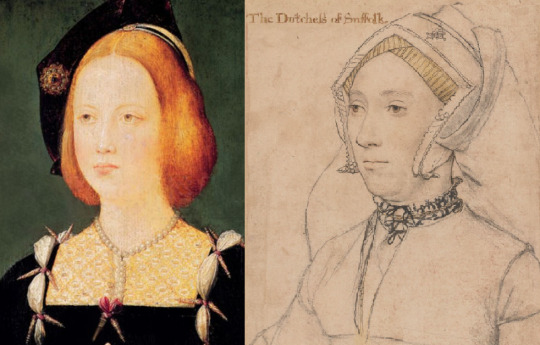
If you used these two and looked solely on neck, you’d never believe it might be same woman:
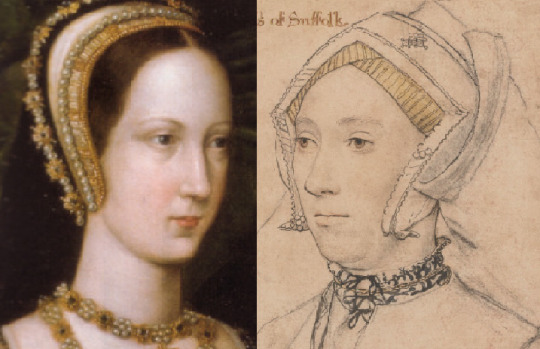
It paradox, but adding certain clothes can make the neck look shorter, in right angle. Being tilded more to side also can significantly shorten the neck.
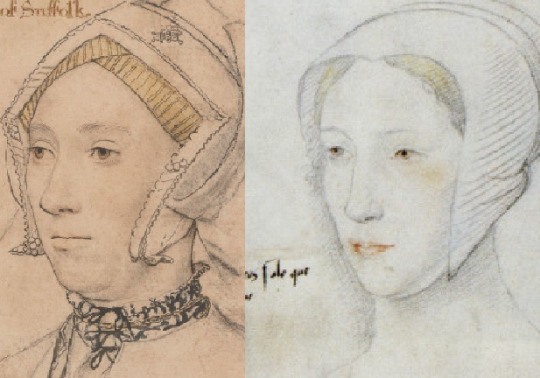
But there is another reason why this doesn’t fit and that is weight gain and aging. We know from portraits of Henry VIII, that his very long neck, over time disappeared. Sometimes due to painter’s skill lacking, but eventually in real. Same thing could have happened to his sister as she aged.
(It’d be unlikely for Isabella at end of her life, to go from having short neck, to suddenly have tall neck. While for Juana with her average neck, I had to cut her some slack, because as younger woman she could have more changes to her body and especially with many pregnancies, it could have affected her appearance.)
And we don’t know how skilled was the person who painted the marriage portrait of Mary Rose. So we don’t know how well executed are those features. Some painters have tendencies to overexagerate some feature, some to downplay them. You have to see multiple depictions of person(best to look at all of them), to make judment and compare all you have, because some painter could have made mistake.
So if I’d have 10 paintings of Queen Isabella with very short neck and 1 with longer-i’d knew that one time is mistake.
Especially given Holbein could have adjusted finished painting and sketch could have had some flaws, we cannot just make judment on one feature alone.
What one actually has to do with these is compare the features one on one. (Unfortunately without pictures of each feature, because post then wouldn’t save. I hate to rob you of it.)
Not rely on lining up the paintings side by side(scaling them to same size), but on our eyes and see how many times it matches and how well. Not if it matches perfectly every single time for every feature.
It’s sketch, not finished painting-we have to allow bigger margin of difference.
We have same shape of face 4/4, except the forehead matches 1/4-this is explainable by different headwear. Gable hood hides most of forehead.
Chin is similiar in 3/4, with differences due to weight gain.
Eyebrows are never same thickness as in Holbein’s sketch, this can be due to different age or Holbein’s practise of getting every hair of eyebrow, which then wouldn’t be on finished painting, but the overall shape of them is otherwise same 3/4 times.
Eyes-1x great match, 2x good match, 1x not so great match
Lips-1xgreat match, 1x good match, 2x not so great match
And then we have the nose.

If we consider the different tilts and angles, and that holbein’s sketch could have partially worn off(less shading hence), I cannot rule it out.
We have similiar alla, nostrils, tip of head, aproximately same width and lenght. Only thing which you might think is different is the shape of nose-Mary’s appears more straighter.
But look at lady Audley’s sketch and miniature first:

See how different the nose looks? And how much prettier she is in finished version? Sketches truly are too harsh upon features.
(and have tendencies to overexagertae even slight raise of nose)
And no, lady Audley eyes aren’t hazel. Imo she is unfortunate victim of alteration upon the sketch. Her eyes are the only(in all of Holbein’s sketches I have seen), not done by coloured pencil, but what seems to me like watercolours. Her hair too(and neither matching well to her real colouring). But you have to see the sketch in HD to realise.
If we take into considerations the issues I talked about above, plus the different tilt and angle, 10+ years, weight gain, i cannot rule it out.
And as I said prior, sometimes that is as close to identifying the sitter as you can get. This might be Henry VIII’s little sister:

In 1526/7, hence aged 30-31.
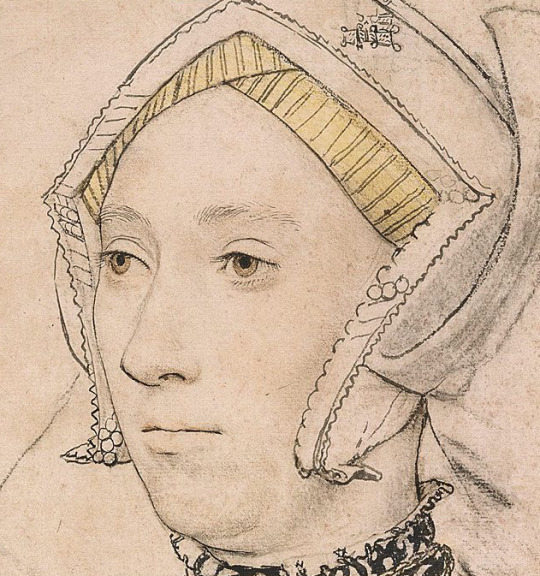
Once again, she probably looked much more prettier in finished painting, at least partially as good as when she was beautiful young girl.
I hope you’ve enjoyed it.
#Tudor History#historical portraits#misidentification#duchess of suffolk#hans holbein the younger#Katherine willoughby#mary rose tudor#mary tudor queen of france
15 notes
·
View notes
Note
I know Elizabeth of York has met the person suspected of murdering the prince in the tower? It makes me curious. It is said that the Queen and her cousin Suffolk are very close, which makes me doubt whether this meeting is for her brother or cousin
Hi! There's actually no direct evidence that Elizabeth was 'very close' to Edmund de la Pole. He was often at court and they were cousins so it's likely that they saw each other and had opportunities to talk but there are no recorded gifts or office appointments from Elizabeth to him, so I wouldn't say they were particularly close like she was to his sister Anne (the abbess of Syon), for example, a cousin with whom she did indeed exchange gifts.
But to go back to your question, yes Elizabeth visited the Tower around the time Sir James Tyrell was imprisoned and interrogated there. No records from Henry's own reign say Tyrell was implicated in the death of Elizabeth's brothers — Tyrell was condemned for his participation in the conspiracy involving Edmund de la Pole — but Thomas More claimed that Tyrell, whilst imprisoned, confessed that Miles Forest and John Dighton killed the princes at his instance. This claim has been extensively doubted but new evidence recently discovered (2020) shows that More was in touch with the sons of one of the men he alleged to have carried out the murder for Tyrell, as he himself indicated in his text: 'as I haue learned of them that much knew and litle cause had to lye, wer these two noble princes [...] murthered'.
Whether Tyrell's real confession that Elizabeth heard was about the murder of her brothers or about her cousin Edmund's treasonous plans, it's interesting that almost immediately after hearing Tyrell's confession Elizabeth left the Tower and visited her aunt Elizabeth the Duchess of Suffolk at her house at Stepney (London). Tim Thornton, who recently wrote an article about it, says that 'the immediacy of this visit might suggest the importance of any revelations from Tyrell in the Tower, and Elizabeth’s desire to pass news of the princes’ fate to their aunt, the last survivor of their parents’ generation'. For the Duchess of Suffok, news of her son's treason could be equally — if not more — important so my opinion is that Elizabeth's visit is no evidence for the confession involving the murder of her brothers.
It's difficult to say though why Elizabeth would have been in any way invited to hear a confession about treasonous activities against her husband the king, when by that point there had been several and she had not been involved in any other of Henry's interrogations carried out in the Tower (Henry's willingness to take a personal role in the questioning of prisoners has been confirmed in other cases but never Elizabeth's). So we'd have to take into consideration both Elizabeth's extraordinary presence and her subsequential visit to her oldest remaining paternal relative.
Thomas More's claim about Tyrell's confession and the fact that he came in contact with the alleged assassin's sons is also very intriguing. A possibility as to why Tyrell was not publicly exposed after his confession is that it would reflect badly on Henry VII for not only allowing the princes' murderers to go unpunished for so long, but also actively favouring them/keeping their privileges intact. It's difficult to say. It's a kind of evidence that definitely does not 'prove' anything.
#elizabeth of york#edmund de la pole#james tyrell#elizabeth of york duchess of suffolk#henry vii#ask#anon#historian: tim thornton
15 notes
·
View notes
Text
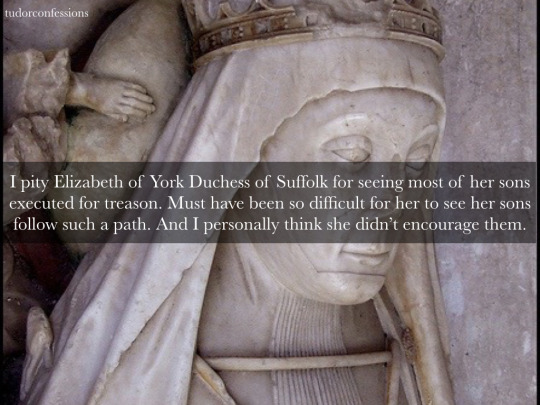
18 notes
·
View notes
Text
i cannot stop thinking about henry vi part 2
#i havent rewatched it yet#i watched part one again (the bbc television production from 1983 directed by jane howell whomstve we STAN)#i havent watched a production of part 2 though... ever. not since i read it four years ago now#in which it was all in my head#AM I READY FOR WHATS GONNA HAPPEN TO THE DUCHESS OF GLOUCESTER THOUGH? AM I?#IM NOT SURE I AM#oooohohoh#shakespeare history plays are breaking my brain#i said i was gonna use july to detox before reading henry v but then i made a kanopy profile oops#margaret of anjou is gonna WHAT? she's gonna WHAT???!??!!?#SUFFOLK WHAT???!?!?!?!?#tales from diana#i also keep thinking about how. i initially had no interest in reading the english history plays whatsoever. lol#if it weren't for ned @sneez my dear friend being the number one henry vi fanboy inthe world... idk if id have read any of them by now#in truth i only started 1 henry vi bc of him. and i was a bit dismayed and daunted by the fact that it was one of 3#about that king alone... and then to discover richard iii was the end of that tetralogy series.#but then like. i started that shit and i was like WHAATTT?!?!?!?!?#everyone told me shakespeares english histories are just elizabethan propagranda. no one told me that they're general hospital#seriously the medieval court drama is unmatched#i dont get a kick out of true crime like some ppl. for my real-life-intrigue fix i need deposed kings and lord protectors sorry#and several wars going on at once#the pacing in the histories are also nothing like the rest of shakespeare's works. i mean ppl make a joke about hamlet#how basically the whole play he does nothing but go insane and soliloquize until he dies#IT IS NOT LIKE THAT IN THE ENGLISH HISTORIES#PPL WILL BE BANISHED FROM THE REALM ON PUNISHMENT OF DEATH IN FUCKIN. ACT II OF V. SHIT'S CRAZY
4 notes
·
View notes
Quote
The secret Suffolk himself threatened to expose to the public (and intimated by his speeches in parliament) was that he had not acted alone — much of the nobility had lent their support to the truce negotiations with France, and Suffolk was not solely to blame for the fiasco in Normandy. So the duke was saved by the king, and sent into exile for five years. (Perhaps the greater secret was Henry VI’s incapacity to rule, clearly apparent to those at the centre.) The night before he set out for the continent, Suffolk, who was married to Alice Chaucer, granddaughter of the poet, wrote to their seven-year-old son in loving terms — this letter too is preserved in the Paston letters. He instructed his son John "to be trewe liege man in hert, in wille, in thought, in dede, unto the Kyng…to whom bothe ye and I been so moche bounde to…" and "to love, to worshepe youre lady and moder, and also that ye obey alwey hyr commaundements, and to beleve hyr councelles and advises in alle youre werks". Private correspondence, particularly to someone of Suffolk’s station, was one of courtesy and intimacy, as too was the world of poetry in which he was also immersed through his friendship with Charles d’Orleans. Thus how alien this world of public writing with its slanderous attacks must have seemed to him, one which seemed deliberately to parody the ballades and roundels of the aristocratic world. But isn’t this is what tabloids do? They parody both elite and middlebrow forms of communication.
Clementine Oliver, "Murdered in the Tabloids: Billposting and the Destruction of the Duke of Suffolk in 1450". Anales de la Universidad de Alicante. Historia Medieval, N. 19 (2015-2016)
#william de la pole duke of suffolk#henry vi#charles duke of orleans#alice chaucer duchess of suffolk#the court of henry vi#the death of suffolk#historian: clementine oliver
2 notes
·
View notes
Text
Guildford Dudley, Husband of Lady Jane Grey
Guildford Dudley, Husband of Lady Jane Grey
19th C. image of Guildford Dudley from the (c) Palace of Westminster; Supplied by The Public Catalogue Foundation
“Your loving and obedient son wishes unto your grace long life in this world with as much joy and comfort, as did I wish to myself, and in the world to come joy everlasting. Your most humble son to his death, G. Duddley” – note in a prayerbook from Guildford to his father-in-law,…
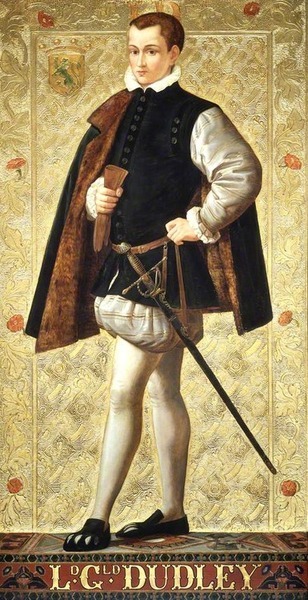
View On WordPress
#Archbishop of Canterbury#Duchess of Northumberland#Duke of Northumberland#Duke of Suffolk#Edward VI#Elizabeth I#Guildford Dudley#Henry Grey#Henry VIII#Jane Guildford#John Dudley#Katherine Grey#King of England#King of Spain#Lady Jane Grey#Lady Margaret Clifford#Marchioness of Northampton#Mary Grey#Mary I#Philip II#Queen of England#Simon Renard#Thomas Cranmer#Tower of London#Tudor history#Wyatt’s Rebellion
10 notes
·
View notes
Text
Book Review - 'Tudor Roses: From Margaret Beaufort to Elizabeth I' by Amy Licence
Book Review – ‘Tudor Roses: From Margaret Beaufort to Elizabeth I’ by Amy Licence
I was so excited to get a review copy of this book from Pen and Sword. It doesn’t disappoint as it discusses the Tudor women across the whole period and how they compare to each other in their styles of motherhood, queenship, and relations with the men in their lives. It shows how resilient the women were and how essential they were to the dynasty. It doesn’t just examine the period 1485 to 1603…

View On WordPress
#Amy Licence#Anne Boleyn#Anne of Cleves#Elizabeth I#Elizabeth of York#Elizabeth Woodville#Gender#Jane Grey#Jane Seymour#Katherine Howard#Katherine of Aragon#Katherine Parr#Margaret Beaufort#Margaret Queen of Scotland#Margaret Tudor#mary duchess of suffolk#Mary I#Mary Tudor#tudor roses#Tudors#Women
10 notes
·
View notes
Text


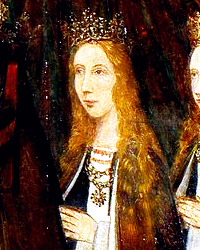



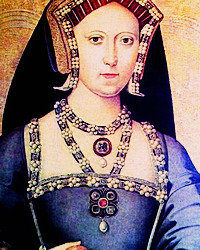
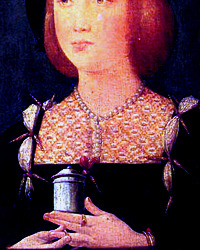
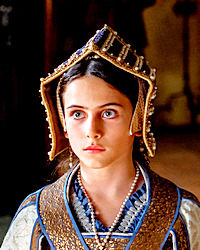
♕ @dailytudors: TUDOR WEEK 2023 ♕
Day Two: Favourite Female Tudor Family Member >> 2/3 - Mary Tudor, Queen of France, Princess of England, and Duchess of Suffolk
#the spanish princess#the sword and the rose#perioddramaedit#tudorweek2023#thespanishprincessedit#sai bennett#glynis johns#isla merrick lawless#mary tudor queen of france#mary tudor#mary rose tudor#my edits#dailytudors
196 notes
·
View notes
Text
OTD 1545. Death of Charles Brandon, K.G, Duke of Suffolk at the age of 60. Married 4 times, and former brother in law to Henry VIII, Brandon was possibly the closest friend Henry ever had. 👑❤️
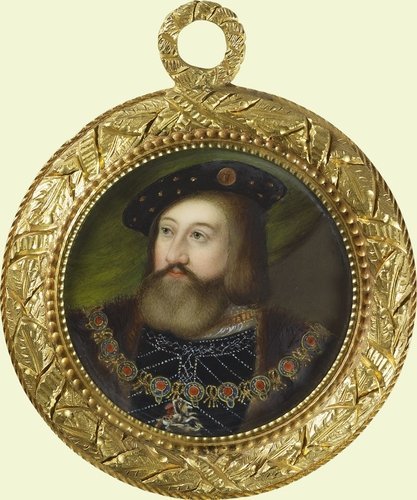
#charles brandon#duke of suffolk#the tudors#tudors#henry viii#mary tudor queen of france#mary tudor brandon#katherine willoughby#duchess of suffolk
11 notes
·
View notes
Text
Now I’m Covered In You [Chapter 2: Dusk]

Series summary: Aemond is a prince of England. You are married to his brother. The Wars of the Roses are about to begin, and you have failed to fulfill your one crucial responsibility: to give the Greens a line of legitimate heirs. Will you survive the demands of your family back in Navarre, the schemes of the Duke of Hightower, the scandals of your dissolute husband, the growing animosity of Daemon Targaryen…and your own realization of a forbidden love?
Series title is a lyric from: Ivy by Taylor Swift.
Series warnings: Language, sexual content (18+), dubious consent, miscarriage, pregnancy, childbirth, violence, warfare, murder, alcoholism, sexism, infidelity, illness, death, only vaguely historically accurate, lots of horses!
Word count: 4.0k.
Link to chapter list (and all my writing): HERE.
Taglist: @borikenlove @myspotofcraziness @ipostwhatifeel @teenagecriminalmastermind @quartzs-posts @tclegane @poohxlove @narwhal-swimmingintheocean @chainsawsangel @itsabby15 @serrhaewin @padfooteyes @arcielee @travelingmypassion @what-is-originality @burningcoffeetimetravel @blackdreamspeaks @anditsmywholeheart @aemcndtargaryen @jvpit3rs @sarcastic-halfling-princess @flowerpotmage @ladylannisterxo @thelittleswanao3 @elsolario @tinykryptonitewerewolf @girlwith-thepearlearring @minttea07
Let me know if you’d like to be added! 💜
The girl is from Milan, and Daeron is enamored with her: bright-eyed, beaming, blood rosy in his cheeks. Her name is Nicolosa, though she is adamant that everyone should call her Nico. She is one of those effortlessly informal people. She laughs too loudly and says all the wrong things, too-honest observations that would be offensive if the person breathing life into them was anyone but her. She spins around the hall as violins and lutes play, swinging from the willing arms of chuckling noblemen, an aisle of light in a goldenrod gown, the sun made flesh. She has the luxury of dancing until breathless, until she glows with the sheen of exertion. She could not possibly be carrying a child; she will not be wedded and bedded for another year.
This is a great triumph for Otto the Duke of Hightower. Milan under the House of Sforza is an enviable ally, wealthy and sophisticated, and eager for friends who will one day be willing to assist them in resisting French encroachment. This is the deal that the Duke of Hightower has struck. True, Daeron is still rather young to take a bride. True, Nico’s parents, the Duke and Duchess of Milan, were insistent that they would concede to the match only if the marriage and consummation was postponed until next August. True, this does not resolve the immediate concern of Aegon’s lack of an heir. But it is another tile of a mosaic, another thread in the patchwork of the Greens’ objectives, another brick in a castle wall from which boiling oil could be poured down upon invaders.
The Duke of Hightower is accepting warm congratulations from the nobility of Southern England: Norfolk, Gloucester, Somerset, Buckingham, Suffolk, Clarence, Exeter. Those of the North—Lancaster, York, Stark—shun him. They stand instead with Rhaenyra, admiring her two eldest sons, pretending not to notice how little they resemble the late Laenor Velaryon. The Crown Princess is wearing black accented with maroon, as she almost always is. She sends a small, reassurance-seeking smile to where Daemon sits at the high table, and he raises his cup to her, his face sly, arrogant, proud. They love each other, this is clear; it may not be an especially conventional love, and it may be a love that emboldens rather than tames, but it is love nonetheless. This does not make your resignation to your own fate any easier. Queen Alicent, laughing as she joins Daeron and Nico dancing, is dressed in dark green to match her father and her children. You often wear purple, the color of royalty…just to remind people that you still deserve to be here.
You are at the high table too, albeit on the opposite side from Daemon; the Blacks are always seated to King Viserys’ right, while the Greens are on his left. Aemond doesn’t dance, you aren’t permitted to, Aegon is too drunk. He’s apparently not too drunk to leer, however; his bleary storm-blue eyes follow Lady Joanna Montford as she glides across the floor like a shark through surf, flashing luring eyes and flirtatious simpers. You’re a better dancer than she is, but of course that doesn’t matter, because no one ever gets to see you do it. Aegon won’t go so far as to touch her in public—he would consider that discourteous, you think—but he’s sleeping with her, and everyone knows he’s sleeping with her, and you can’t even truly wish he’d stop because you don’t want him in your bed anyway. But the humiliation of it…the hopelessness…that is more difficult to come to terms with.
“Portugal,” Daemon tells Aegon nonchalantly. “You could have married some princess from Portugal.”
Aegon guzzles his wine and says nothing. Aemond—scribbling messy lines of black ink onto parchment at the end of the table—glances up at you and then back down again.
Daemon continues: “The Infanta Maria was wed around the same time you were, and she’s produced a more than satisfactory son for her husband. Hugely fat, practically hoglike, I’ve seen portraits.”
“Daemon, please,” King Viserys scolds mildly, smiling as he watches Rhaenyra mingle with nobles who wouldn’t mind burning you alive if it meant the Blacks would ascend more seamlessly to the throne. The king has her son Joffrey in the chair next to him and has enthralled the boy with stories of jousts, hunts, feasts, Christmases and May Days. You wonder if he’s ever shown such interest in any of his children with Alicent. If he has, you aren’t aware of it.
“Or Savoy,” Daemon says. “Not as cultured as Milan, this cannot be denied, but of great strategic significance geographically. One foot in France, the other in Italy. I’ve heard wonderful things about Princess Louise. Very athletic, very…” He smirks, biting into a pomegranate. Ruptured seeds spurt juice like the gleam of rubies. “Flexible.”
“Oh, look, Prince Daemon.” You point into the crowded hall. “I think your wife is beckoning you to join her. Your third wife, I mean, the most recent one. The one who also happens to be your niece.”
“Or Naples!” Daemon exclaims, as if it has just occurred to him, as if he hasn’t been waiting to torment you like a wolf shadows a wounded stag, saliva filling up its mouth, fangs bared and dripping. Southerners detest Daemon because they fear he is mad; but that’s exactly what the North likes about him. “Or perhaps even—would we dare to hope?—a princess of France! Think of it! The poor Duke of Hightower would not know what to do with himself, he would be so delighted. At his age, the shock might just kill him.”
“Daemon,” King Viserys warns again.
“Perhaps you shouldn’t be giving us so many ideas,” Aegon says, slurping his wine. “Aemond is still unspoken for, and now we have a tidy list of candidates to consider. How thoughtful of you.”
“Or you simply could have made the same arrangement that you did but in reverse,” Daemon goes on as if no one else has spoken at all. “You could have taken a Castilian bride, and Helaena could have been shipped off to the Pyrenees, and your circumstances would be wildly different than they are now. Princess Lucia would have been the right age for you. Do you want to know what she gave to her new husband this past Christmas?”
“I surely don’t,” Aegon replies.
Daemon grins beneath glinting eyes. “Twins.”
“Enough,” Aemond says, dark and quiet like midnight.
Now Daemon addresses you, resting his elbows on the table. “How many more chances do you think they’ll give you, Navarre, before some providential technicality that voids your marriage contract is discovered and you are discarded of in a nunnery?” Another bite of the pomegranate; another freckling of bloodlike red across the tablecloth. “The globe is crawling with royal women, they’re fish in a barrel, why would anyone jeopardize their dynastic ambitions for you?”
“My wife belongs where I am,” Aegon says: a fact, a dare. “And I will hear no more of it.”
You look at him, grateful but a little stunned. He does this sometimes. He will choose a seemingly arbitrary moment to make a show of loyalty, and then he will never mention it again. He doesn’t return your glance. Instead, he picks apart a roasted chicken carcass with his fingers and resumes staring at Lady Joanna Montford with his dazed, watery eyes. Aemond, engrossed in his writing, hasn’t eaten much tonight. Neither have you; but there’s a reason for that.
“Where you are,” Daemon muses, raising his strange white eyebrows. “Well, I hope she enjoys brothels.”
You fling back: “Like the one you fondled the Crown Princess in?”
“A baseless rumor,” Daemon replies, but he can’t smother the flare of wicked pride in his eyes.
“Will you stop it?!” the king roars at both of you. Joffrey gazes up at him with awe, like he’s seen a falling star or a dragon or the face of God. “This is supposed to be a joyous occasion, a royal betrothal, and you can’t conduct yourselves appropriately for one night—?!”
“What are they squabbling about?” the Duke of Hightower asks as he approaches the table. He can summon nothing more condemnatory than half-serious annoyance; his mood is too lofty, his victory too fresh. Behind him in the festive ruckus, Queen Alicent and Rhaenyra are exchanging awkward compliments and trying to ignore all the enmity that has stacked up between them since the king married his daughter’s lifelong companion and started producing white-haired children with her. Jace is dancing with Baela, Luke with Rhaena; Daeron and Nico have found themselves alone in a corner, giggling as candlelight glows hot and golden on their flushed cheeks.
Rather than answering, the king merely rolls his eyes and sighs, exasperated.
“You must be overjoyed, Otto,” Daemon says. “Another friend on the Continent. And yet, they are awfully far away, don’t you think?”
The Duke of Hightower smiles tightly. “Ships travel fast.”
“Ah, perhaps, though not faster than word from here to the Scottish border.”
“The Milanese girl will make a lovely bride for young Daeron, Otto,” King Viserys praises. He has either successfully deluded himself into believing that the whole of the realm will miraculously coalesce behind Rhaenyra upon his death, or he is determined to ignore the catastrophe that will ensue once he slips, gleefully ignorant, off into the afterlife.
Daemon nods. “Yes. Buxom, vivacious, amiable, she will be a fine mother someday. Unlike certain other people among us.”
Aegon says around a mouthful of chicken: “Grandsire, Prince Daemon was kind enough to point out all the other advantageous matches still at our disposal. Since we haven’t monopolized our bloodline by marrying exclusively immediate relatives.”
The Duke of Hightower chuckles. “Yes, I do sincerely hope that Jace and Luke’s offspring don’t all end up with fifteen fingers or gills or some such thing.”
“Fortunately, Harwin Strong’s blood should dilute the lineage,” you say.
Daemon turns towards you, twisting in his chair, grinning cruelly. “Gills or not, at least they’ll have children.”
You can’t think of anything to say back. Perhaps there is nothing to say. The Duke of Hightower and Aegon both avert their eyes. King Viserys has returned his attention to young Joffrey and is teaching him a prayer to invoke the protection of Saint George. Only Daemon looks at you; and Aemond watches him, quill hovering in midair, his sole blue eye a blaze of cold fire. You push out your chair and rise from the table, fleeing to one of the rooms adjacent to the exuberant, cheerful hall. You’re happy for Daeron and Nico, truly you are. But pain has a way of feeling heavier than joy, doesn’t it? It grips onto your ankles and drags you down into depths that nobody else can see.
The room is small and empty, the music muffled by the walls. Through the stained glass windows trickle in beams of pink-lavender light as dusk falls over Westminster Palace. And you stand there alone in the twilight, thinking of the past and the future and time itself, a ghost that will always be made of more secrets than answers.
You hear the door open behind you. “I’ll return to the festivities in a moment,” you say to the intruder, trying to keep the emotion from your voice.
“No need,” Aemond replies softly.
You wheel, and there he is, walking to meet you in the vanishing daylight. He takes your left hand in his and settles his right lightly, modestly, on your waist. “What—?” And then you understand.
Dancing. Here, where no one can see to forbid or ridicule. He’s come to take me dancing.
You smile up at him. “I’m not supposed to be doing this.”
“We’ll go very slowly.”
And slowly would be an understatement: you and Aemond move together in dawdling, careful steps, rotating like seasons, like the phases of the moon. He smells like he always does, of work and effort: smoke, leather, that scent he wears that is dark and woodsy and with an edge like a knife. His hands are calloused from sword sparring. Yours feel soft and helpless in his; they weren’t always so fragile, but they are now. “I thought you hated me,” you tell him.
“I’ve never hated you.”
“But you ignored me. For an entire year after I arrived in England, you ignored me.”
“I kept my distance. That’s very different from ignoring.”
“Alright, but why keep your distance at all?”
Aemond hesitates. “I am not in the habit of allowing myself to be noticed.”
“Because you fear people will see through the armor you’re wearing?” And when he abruptly stops dancing, you add: “I don’t mean that unkindly. I’m the same way. I wear all sorts of masks.”
He studies you in the lilac light. His gaze falls from your eyes to your lips to your throat. And then he resumes the unhurried dance. “There’s nothing about you worth hiding.”
You spin away from him and then return to be caught. “And you think you are a trove of scandalous secrets, Prince Aemond? Is that what’s in all those poems you won’t let me read?”
“If they were any good, I’d let you read them.”
“But you have the disposition of a genuine poet. Enigmatic, perceptive…” Alluring. Beautiful. You cast those thoughts away like coins into a wishing well. “Graceful.”
“So the dancing isn’t too terrible. I don’t do it often, I’m afraid.”
“You don’t do it ever to my knowledge. And no, not terrible at all.”
“I move best when holding a sword, not a princess.”
“I used to have callouses like yours, you know,” you say. “My palms and fingers were covered in them.”
“Because you sparred with your brothers,” Aemond remembers.
“For hours and hours. Especially with Alonzo. He’s the exact opposite of you, short and stocky and loud, with dark curls and heavy feet. And his poetry would send a lady sprinting in the other direction.”
“Do you miss it? Terrorizing men with swords?”
“Of course. I was almost somewhat good at that, unlike everything I’m tasked with here.”
Aemond grins, broad and mischievous. “Let’s have a demonstration then.” He releases your hand, goes to the door that leads to a stairwell, and waits patiently for you to join him.
This is improper. This is disobedient. But what has being obedient gotten you lately?
You follow Aemond through the doorway, down the stone steps, and out into the courtyard illuminated by dusk like amber, tiger’s eye, amethyst, rose quartz. It is empty except for the two of you; the rest of the palace is thoroughly occupied with drinking, dancing, and murderous scheming. It is a wonder with as lethal as the world is that women are meant to be so powerless. Aemond trots across the grass towards the blacksmith’s forge at the far end of the courtyard, then returns with two swords. He passes you the lighter one.
“How does it feel?” he asks you.
You twirl the sword a few times, admittedly rather inexpertly. “Wonderful. But I’m very out of practice.”
“Fear not. We’ll take this slow as well.” He taps his blade against yours, so tenderly it’s laughable; the sound it makes is blunt and low. Still, you’re both smiling as you circle each other, striking out with intentionally ineffectual thrusts and lunges, blocking, parrying. “Your footwork is excellent,” Aemond notes.
“It used to be better. But I appreciate your compliment. You’re more talented than Alonzo. Then again, you probably spend much less time skipping lessons to chase women around.”
“Undoubtedly,” Aemond says in a tone you can’t decipher. Then he asks, interest piqued: “What sorts of masks do you wear?”
You shrug, your blade skating down the length of his. “All sorts.”
Aemond parries. “I’d be interested to know.”
“A genuine poet would be astute enough to sift out the truth from the lies.”
“So lie to me,” Aemond says, his stare direct and bold, his sword balanced in one hand and pointed at your ribs, your heart. “And we shall find out if I can tell.”
You side-step him, thinking of frivolous diversions. “I love English ale and drink it all the time.”
“Lie. Apple cider.”
The blades clang. “My favorite color is, dutifully, green.”
“Lie. Red, like the flag of Navarre.”
And like blood. “It’s beginning to lose its charm,” you confide in Aemond.
“Don’t do that,” he says severely. “Don’t let them take something you’re proud of away from you.”
You consider him as stars rise in a violet sky. “Why are you encouraging my rebellious inclinations? You don’t give the impression of being much of a rule breaker.”
“I don’t see what good can come from you being denied any source of happiness,” he says simply. “Go on. Let’s have another attempt at a lie.”
You block Aemond’s benign, cautious swing as you circle him. “I’m pregnant again.”
Aemond halts; every muscle in his body goes still and inflexible. And he knows immediately that you’re telling the truth. “I’m…I’m very glad to hear that,” he manages at last.
You laugh fleetingly, cynically. “You can’t even properly congratulate me. No one can. Because everything’s gone so horribly thus far, people don’t want to get their hopes up.”
“Does anyone else know?”
“Not yet. But I can recognize the first signs by now.” Constant low-level nausea, difficulty waking in the morning, dull cramping. You force a thin smile. “At least your brother won’t need to visit my bed for a while.”
“You don’t find pleasure with him? Is Aegon not…” Aemond searches for the right word, nervous, bashful. Hot blooms of blood appear in his cheeks. “Attentive to you?”
“It’s not his fault. He tries, really. He’s never been selfish or rough. It is entirely my own deficiency. I’m just not…at ease with him, I suppose. I can’t relax enough. I can’t reach…well…” Euphoria? A climax? A peak? You know what euphemisms others use, but it’s difficult to describe something you’ve never experienced before.
Aemond nods, meaning that he understands, that you don’t have to wrench the words out of you like entrails from a slaughtered animal.
“I know that other women can,” you say, tapping your blade against his. “That their husbands are well-matched with them and that they enjoy great pleasure. It’s difficult for me to accept that isn’t something I’ll ever get to have myself. At least…I don’t believe I’ve ever had it.”
“I think you’d know if you had.”
“Oh, and you’re an expert in a woman’s pleasure, are you? As an unmarried prince?” Your voice is casual and teasing; but the thought of him with a lover is like a bolt of lightning. It pains you, it paralyzes you, it hits you without any warning.
“Years ago, Aegon paid for a woman to…initiate me,” he explains. “Several times. He meant it as an act of compassion, I think. I was speechless around anyone I found desirable.”
Your nausea swells from a ripple to a wave. “Oh. I see.”
“It’s not something that I especially wanted at the time, and it’s not something that I have cared to repeat since. But it was very…informative.”
He gives you an infinitesimal little half-smile, and something passes between you as the last threads of dusk are unwoven from the sky and night engulfs Westminster Palace, something like a promise, a note, a whisper. The queasiness in your belly vanishes and is replaced by something else: a sensation like falling, like wanting. You are overcome by an ache to say something, though you don’t know what.
“What the hell are you doing?!” the Duke of Hightower bellows, striding out into the courtyard. Aemond takes several swift steps away from you and hurls his sword to the ground. You toss yours away as well.
“Grandsire, the princess and I were just—”
“You!” the Duke of Hightower shouts, turning on you first. “You should be in a chair or in bed, you should be resting, you should be thinking only of your health and of the wellbeing of the heirs you will produce with Aegon, not gallivanting around in the darkness and playing with swords, of all things! What would your husband say? What would your parents say?! Are you what we were promised when we signed that godforsaken contract?! Surely, princess, at this very moment you are not.”
Aemond begins: “Grandsire, it wasn’t her idea—”
“And you,” the Duke of Hightower growls at him. “You will immediately rid yourself of your baffling aversion to marriage, because you’re next, Aemond. Be prepared to discuss the candidates tomorrow and decide upon your preferred bride. Your brothers and sister are spoken for. We have one last card to play, and it cannot wait any longer. Not with this enduring…” He glances bitterly at you. “Uncertainty.”
Since you arrived in England, there have been innumerable discussions of who Aemond will marry, and he has staunchly evaded every proposed match. His rationale has wavered from needing to focus on his studies to committing himself to training as a warrior to interrogating the strategic wisdom of each potential alliance. This is strange for a man who is otherwise so constrained by familial loyalty, so devoted to the advancement of the Greens. “I won’t even get to meet her first?”
“You’ll learn to like her. Daeron met his betrothed today and he is happy.”
“Daeron is lucky,” Aemond objects. “I might just as easily not be.”
“You will marry,” the Duke of Hightower insists. “Without protest and without further delay.”
Aemond looks down at his empty hands—lines and callouses, fresh scars and ancient heritage—and he says quietly: “Do you care nothing for love?”
“Have you ever wondered why the old put so little stock in love, Aemond?” the Duke replies. “It’s not because we don’t believe it’s real. It’s because we know it doesn’t last. Women die in childbirth. Men die at war. Thousands die of Plague or the bloody flux. People who once would have killed for you grow to hate you, or worse, feel nothing for you at all. Love is transient and painful and changeable and destructive. Best to skip over such things and think of legacy instead. That’s all any of us are left with in the end.”
And then the Duke of Hightower clasps your wrist and leads you back inside the palace, gently, as if you are made of glass.
~~~~~~~~~~
It is several hours later when Aegon staggers noisily into your bedchamber, knocking over a Florentine vase by the door. Shards of it tumble across the floorboards like wounded men littering a battlefield.
“Sorry,” he slurs, pulling off his tunic and then the plain white shirt underneath. “I’m very drunk, wife, I cannot deny it, but there’s only one part of me that you’re in need of and I think that I can still get it up—”
“Aegon.” You’re lying in bed and sipping a cup of apple cider. “You don’t need to stay. Your part is done.”
He stops cold and blinks at you, comprehending it sluggishly. His eyes flick down to your belly, covered by a blanket decorated with green roses. “Oh.”
“It’s alright. You can go now. You have other places to be, and I know that’s what you want.”
“Is there anything I can do for you? To make it easier?”
Be a different sort of man. Be more like Aemond. “No, I’m fine. But it’s very sweet of you to ask.”
“Okay.” He lurches away, stepping on pieces of the shattered vase. His bare feet leave stains of blood on the floor. And then he pauses under the doorframe, gripping it so he doesn’t fall over. “Wife?”
“Yes?”
“It’s not that there’s anything wrong with you, you know,” he says. “It’s the pressure of it all. It’s the responsibility. I don’t have to feel that when I’m with anyone else.”
I don’t wish he was more like Aemond. I wish he WAS Aemond. “I understand, Aegon.”
He gives you a pitiful, off-kilter, childish smile. “Goodnight,” he says just before he leaves, clutching the doorframe with clawed hands. And then: “Goodnight to both of you.”
300 notes
·
View notes
Text
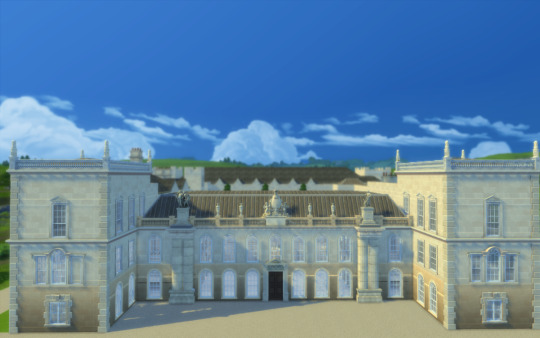

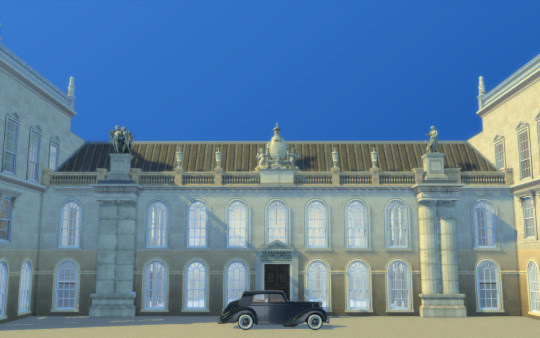

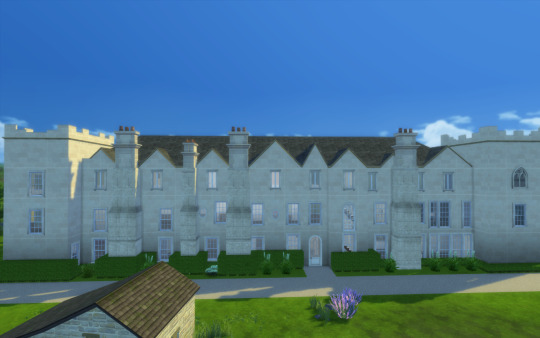
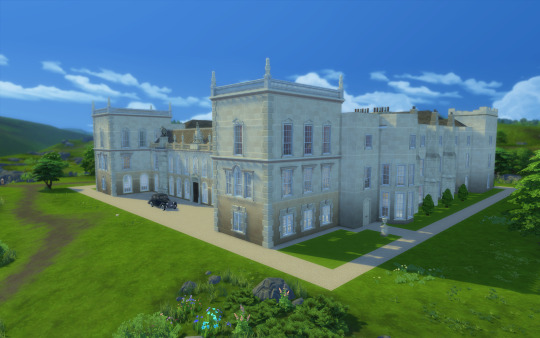
Grimsthorpe Castle
Hi guys!!
I'm sharing another grand english state!
House History: The building was originally a small castle on the crest of a ridge on the road inland from the Lincolnshire fen edge towards the Great North Road. It is said to have been begun by Gilbert de Gant, Earl of Lincoln in the early 13th century. However, he was the first and last in this creation of the Earldom of Lincoln and he died in 1156. Gilbert's heyday was the peak time of castle building in England, during the Anarchy. It is quite possible that the castle was built around 1140. However, the tower at the south-east corner of the present building is usually said to have been part of the original castle and it is known as King John's Tower. The naming of King John's tower seems to have led to a misattribution of the castle's origin to his time.
Gilbert de Gant spent much of his life in the power of the Earl of Chester and Grimsthorpe is likely to have fallen into his hands in 1156 when Gilbert died, though the title 'Earl of Lincoln' reverted to the crown. In the next creation of the earldom, in 1217, it was Ranulph de Blondeville, 4th Earl of Chester (1172–1232) who was ennobled with it. It seems that the title, if not the property was in the hands of King John during his reign; hence perhaps, the name of the tower.
During the last years of the Plantagenet kings of England, it was in the hands of Lord Lovell. He was a prominent supporter of Richard III. After Henry VII came to the throne, Lovell supported a rebellion to restore the earlier royal dynasty. The rebellion failed and Lovell's property was taken confiscated and given to a supporter of the Tudor Dynasty.[2]
The Tudor period
This grant by Henry VIII, Henry Tudor's son, to the 11th Baron Willoughby de Eresby was made in 1516, together with the hand in marriage of Maria de Salinas, a Spanish lady-in-waiting to Queen Catherine of Aragon. Their daughter Katherine inherited the title and estate on the death of her father in 1526, when she was aged just seven. In 1533, she became the fourth wife of Charles Brandon, 1st Duke of Suffolk, a close ally of Henry VIII. In 1539, Henry VIII granted Charles Suffolk the lands of the nearby suppressed Vaudey Abbey, founded in 1147, and he used its stone as building material for his new house. Suffolk set about extending and rebuilding his wife's house, and in only eighteen months it was ready for a visit in 1541 by King Henry, on his way to York to meet his nephew, James V of Scotland. In 1551, James's widow Mary of Guise also stayed at Grimsthorpe. The house stands on glacial till and it seems that the additions were hastily constructed. Substantial repairs were required later owing to the poor state of the foundations, but much of this Tudor house can still be seen today.
During Mary's reign the castle's owners, Katherine Brandon, Duchess of Suffolk (née Willoughby) and her second husband, Richard Bertie, were forced to leave it owing to their Anglican views. On Elizabeth's succeeding to the throne, they returned with their daughter, Susan, later Countess of Kent and their new son Peregrine, later the 13th Baron. He became a soldier and spent much of his time away from Grimsthorpe.
The Vanbrugh building
By 1707, when Grimsthorpe was illustrated in Britannia Illustrata, the 15th Baron Willoughby de Eresby and 3rd Earl Lindsey had rebuilt the north front of Grimsthorpe in the classical style. However, in 1715, Robert Bertie, the 16th Baron Willoughby de Eresby, employed Sir John Vanbrugh to design a Baroque front to the house to celebrate his ennoblement as the first Duke of Ancaster and Kesteven. It is Vanbrugh's last masterpiece. He also prepared designs for the reconstruction of the other three ranges of the house, but they were not carried out. His proposed elevation for the south front was in the Palladian style, which was just coming into fashion, and is quite different from all of his built designs.
The North Front of Grimsthorpe as rebuilt by Vanbrugh, drawn in 1819. Vanbrugh's Stone Hall occupies the space between the columns on both floors.
Inside, the Vanbrugh hall is monumental with stone arcades all around at two levels. Arcaded screens at each end of the hall separate the hall from staircases, much like those at Audley End House and Castle Howard. The staircase is behind the hall screen and leads to the staterooms on the first floor. The State Dining Room occupies Vanbrugh's north-east tower, with its painted ceiling lit by a Venetian window. It contains the throne used by George IV at his Coronation Banquet, and a Regency giltwood throne and footstool used by Queen Victoria in the old House of Lords. There is also a walnut and parcel gilt chair and footstool made for the use of George III at Westminster. The King James and State Drawing Rooms have been redecorated over the centuries, and contain portraits by Reynolds and Van Dyck, European furniture, and yellow Soho Tapestries woven by Joshua Morris around 1730. The South Corridor contains thrones used by Prince Albert and Edward VII, as well as the desk on which Queen Victoria signed her coronation oath. A series of rooms follows in the Tudor east range, with recessed oriel windows and ornate ceilings. The Chinese drawing room has a splendidly rich ceiling and an 18th-century fan-vaulted oriel window. The walls are hung with Chinese wallpaper depicting birds amidst bamboo. The chapel is magnificent with superb 17th-century plasterwork.
More history: https://en.wikipedia.org/wiki/Grimsthorpe_Castle
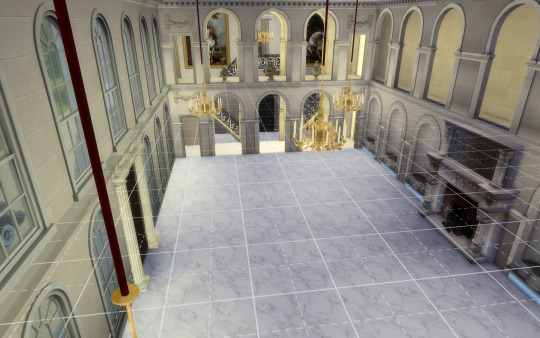



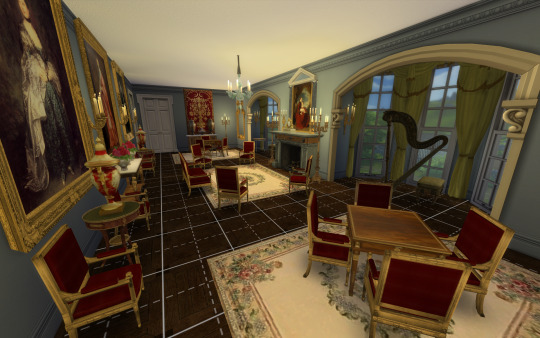
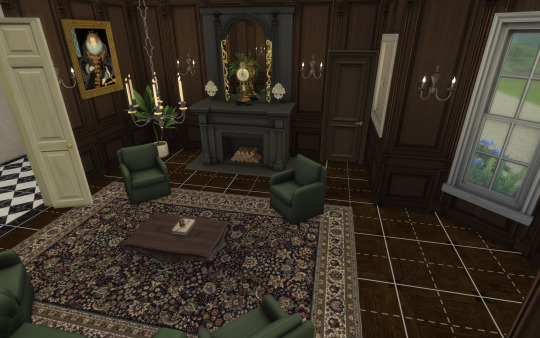
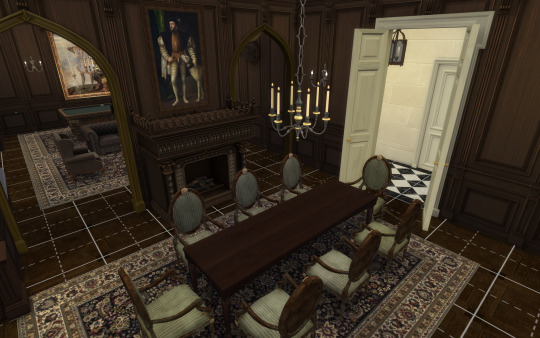
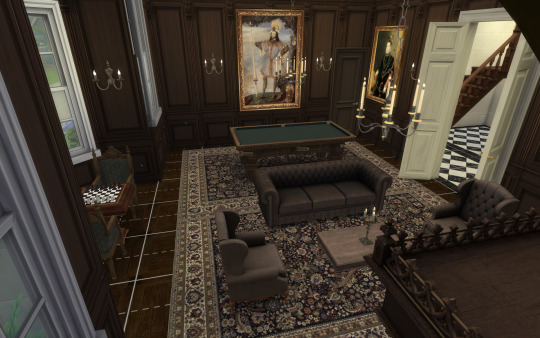


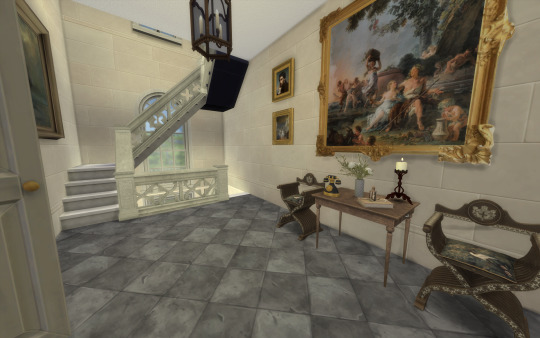
This house fits a 64x64 lot and features several impressive rooms, more than 29 bedrooms, a servants hall and several state rooms!
I only decored some of the main rooms, for you to have a glimpse of the distribution. The rest is up to you, as I have stated that I do not like interiors :P
Be warned: I did not have the floor plan for the tudor rooms, thus, the distribution is based on my own decision and can not fit the real house :P.
You will need the usual CC I use: all of Felixandre, The Jim, SYB, Anachrosims, Regal Sims, TGS, The Golden Sanctuary, Dndr recolors, etc.
Please enjoy, comment if you like it and share pictures with me if you use my creations!
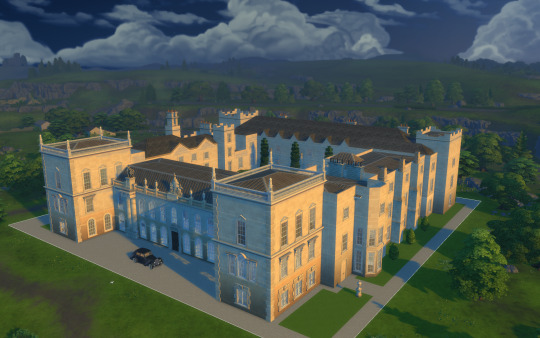





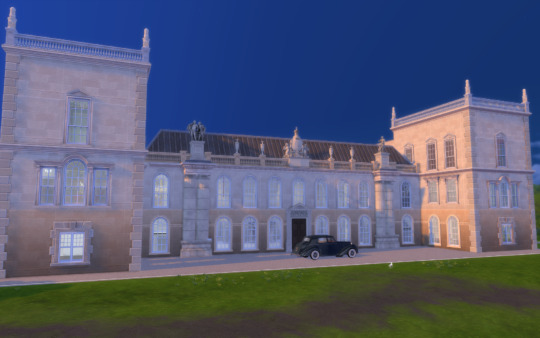


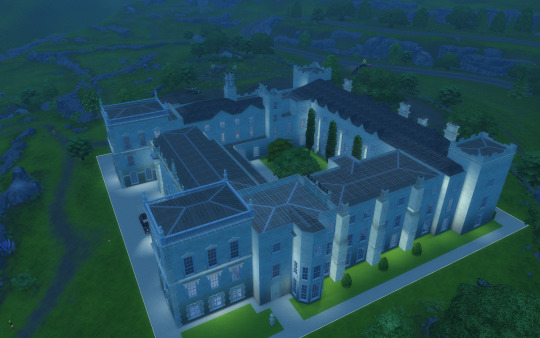
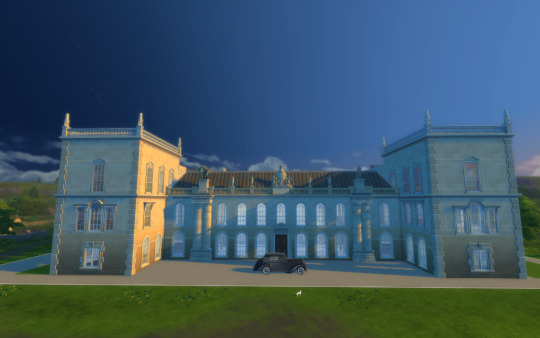
DOWNLOAD (Early acces: June 30) https://www.patreon.com/posts/grimsthorpe-101891128
#sims 4 architecture#sims 4 build#sims4#sims4play#sims 4 screenshots#sims 4 historical#sims4building#sims4palace#sims 4 royalty#ts4 download#ts4#ts4 gameplay#ts4 simblr#ts4cc#ts4 legacy#sims 4 gameplay#sims 4 legacy#sims 4 cc#thesims4#sims 4#the sims 4#sims 4 aesthetic#ts4 cc#english manor
34 notes
·
View notes
Photo
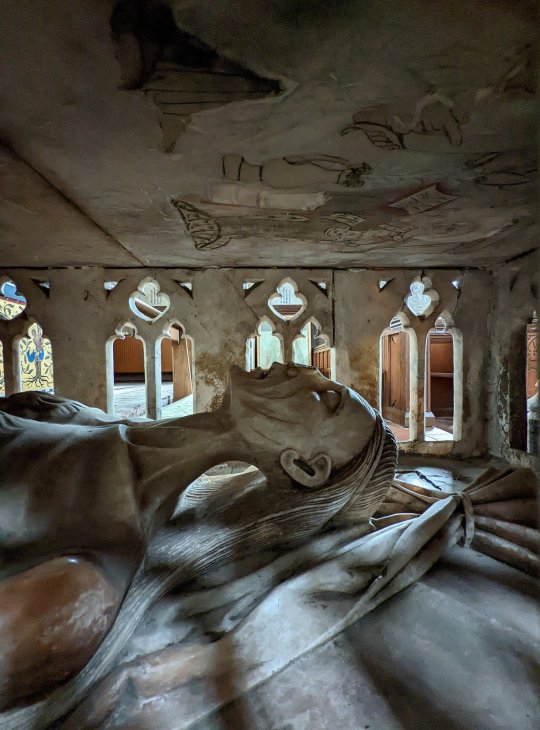
Detail of Alice Chaucher’s tomb, St Mary's Church, Ewelme, 1470s
Duchess of Suffolk and granddaughter of Geoffrey Chaucer, Alice is buried in an elaborated cadaver monument, a two-tiered tomb that was fashionable in the Late Middle Ages. While the top tier shows a dignified effigy of Alice in life, wearing the Order of the Garter, in the one at the bottom she is shown as a decaying corpse staring at a painting of the Annunciation.
Photo by Fiona Charters [x]
177 notes
·
View notes
Note
what did cicely neville do in edward iv's reign?
Hi! Cecily’s entire role during Edward IV’s reign is too long and complex to fully get into right now, so this is just going to be a very brief overview. It’s also not going to touch on her relationship with her daughter-in-law Elizabeth, even though that's somewhat relevant here in some aspects, because that’s also too complex and speculatory.
Ironically, despite the Duke of York’s claims to kingship, it was only after his death and during her widowhood that Cecily Neville truly emerged as a “quasi-queen”. After her son Edward IV had been acclaimed as King in London, and before he left for Towton with the other lords, he summoned the mayor and “all the notables of London” to gather and “recommended them to the duchess his mother”. During his absence, Cecily would preside over his household in Baynard Castle and was probably meant to act as his representative of sorts in the city. After his kingship was more firmly established, Cecily primarily resided at Westminster with him from 1461-64 and regularly accompanied him on several ceremonial and political occasions, such as their visit to Canterbury where she was magnificently welcomed. She also appears to have had a great deal of personal and political influence with her son: Nicholas O’Flanagan, the contemporary Bishop of Elpin, observed in the first few years of Edward IV's reign, his mother could “rule the king as she pleases.”
Cecily’s role demonstrably changed after Edward’s marriage to Elizabeth Woodville in 1464. She remained the second-highest ranked woman in the country, but she took a significant step back from high politics (a la Joan of Kent after her son’s marriage to Anne of Bohemia). That does not mean that either of them suddenly became apolitical or uninvolved: quite the opposite*. Cecily remained the head of a large household, her administration supported her son’s, she continued to support a few religious institutions, she engaged in trade, she launched court cases, and she clearly inspired loyalty among her affinity. All of this was fairly standard for a medieval noblewoman, but was naturally enhanced by Cecily’s own prominent royal status. Cecily was godmother to at least three of the royal children: Elizabeth of York, her namesake Cecily, and the youngest child, Bridget. She also played a role in reconciling her son George to the Yorkist cause in 1471, though she did not have the spearheading role which has often been erroneously credited to her by historians (ie: “engineering peace between her warring sons”); instead, it was her daughters Anne and Margaret who took the leading role in achieving the reconciliation, while Cecily probably aided them. She was also clearly perceived to be influential with Edward IV, best evidenced by how the mayors of Norwich petitioned her to aid them against the Duke of Suffolk in 1480, though we don’t actually know the result of Cecily’s intervention to judge whether it succeeded or how effective it was**. Regardless, though, she evidently had a much lower national profile during these years.
(On a more personal level, we also have a very sweet anecdote from Elizabeth Stonor who spoke of a meeting between Cecily and Edward in October 1476 at Greenwich: 'and ther I sawe the metyng betwyne the Kynge and my ladye his Modyr. And trewly me thowght it was a very good syght’.)
Cecily’s numerous titles are also interesting. Immediately after Edward IV’s ascension, she called herself “the Kyngs Moder, Duchess of York”. Variations of the title included references to her late husband, but she primarily defined herself in relation to her son, through whom her current position and power derived. As Laynesmith says: "narrative accounts, particularly chronicles, had naturally used the phrase ‘the king’s mother’ to describe women in the past, especially Joan of Kent. However, it was Cecily who turned this into a specific title in her letters and on her seals." A few months after Edward's marriage was announced, Cecily adopted a new title, now styling herself as: “By the ryghtful enheritors Wyffe late of the Regne off Englande & of Fraunce & off ye lordschyppe off yrlonde, the kynges mowder ye Duchesse of Yorke.” This referenced the Yorkist perception of her husband, Richard Duke of York, who was called the "true and indubitable heir" of England. In 1477, a herald for the wedding of her grandson Richard of Shrewsbury styled Cecily as “the right high and excellent Princesse and Queene of right, Cicelie, Mother to the Kinge”. This was once again linked to her husband’s status: Cecily described him in her letters as “in right King of England and of France and lord of Ireland”. All in all, Cecily’s various designations appear to have been designed to signify her own importance within the regime, to uphold the claim of her late husband, and to strengthen Edward IV’s position by promoting him as the son of the supposedly rightful heir. It’s also very possible, as Laynesmith has suggested, that “it was as her queenly power diminished [after the early 1460s] that her claims to queenship were more elaborately emphasized in wax and on parchment”.
Cecily’s role and prominence, and how it changed overtime, is best demonstrated by the number of times English subjects offered prayers for her soul in return for grants. Between June 1461 and September 1464, there are twelve instances of grants made to people who offered prayers for her. (To compare, during the first three years of Elizabeth Woodville's queenship, there were sixteen grants of the same type. So, Cecily didn't quite reach the level of the queen, but she came close; it was quintessential "quasi-queenship"). However, mentions of Cecily dramatically deceased following Edward IV's marriage: over the next 19 years till 1483, she is only mentioned five times, and in all cases Elizabeth Woodville was also listed before she was. Three of these mentions are in 1465, likely reflecting contemporary unease with her son's controversial marriage and the perceived unsuitable origins of the new queen. After that, however, Cecily is mentioned only twice: once in 1476 and once in 1481, with the latter being a grant to her own son-in-law Thomas St. Leger***. This fits well with what I mentioned above about her quasi-queenship in the early 1460s, followed by a much more reduced role and lower national profile in the future years.
Hope this helps!
*Oddly, Cecily is not mentioned at all in contemporary reports for her daughter Margaret’s wedding. Laynesmith believes that she was unwell, and that may as well be true, but Margaret's celebrations went on for a great period of time and it does seem conspicuous that Cecily was entirely absent from them all. It's also worth noting that a letter from the Milanese ambassador Giovanni Pietro Panicharolla on the marriage wrote that "the king, the queen, her father, and the king's brothers are all disposed to it" (sidenote: it's VERY interesting that the queen's father is mentioned before the king's own brothers and male heirs) but made no mention of Cecily. Nor, iirc, was she mentioned in the tournament held to celebrate Anglo-Burgundian relations. It does clearly seem as though Cecily did not play a notable role in the marriage, and relevant diplomacy, at all. (Laynesmith's claim that Cecily had "helped lay the ground for" the marriage because she *checks notes* dispatched both her sons to Burgundy in middle of a civil war 7 years earlier, with many fluctuations in Anglo-Burgundian relations in between, is, I'm sorry to say, nonsense).
** Laynesmith believes that "Cecily’s intervention to control Suffolk perhaps marked a turning point in the duke’s violent career because when he resorted to force again the following summer his victim successfully reclaimed the manor from which he had personally ejected her." I think that Laynesmith is being far too assumptive and that we don’t even know the result of Cecily’s intervention in 1480 to somehow credit her with entirely different case one year later that did not even involve her, lol.
***Even more oddly, Cecily’s own son Richard didn’t include her among the list for who to offer prayers for in his college in Middleham in 1478. This was despite the fact that he had included Edward IV, Elizabeth Woodville, his wife Anne, his sisters, his dead brothers and his dead father. It’s incredibly striking, and I wonder what could have happened to cause her exclusion, especially since she was included in religious foundations by both Edward and her son-in-law Thomas St. Leger? Laynesmith claims that "this rather suggests that Richard's own piety was not consciously influenced by hers", and sure, that seems obvious, but it certainly can't have been the only reason. Was she merely overlooked (unlikely), or did they have a quarrel at the time, or was it for another now-unknown reason? Whatever the case, it's a small but intriguing detail to me.
Sources:
"Cecily, Duchess of York" by J.L. Laynesmith
"A Paper Crown: The Titles and Seals of Cecily, Duchess of York" by J.L. Laynesmith (The Ricardian)
"Cecily Neville: Mother of Kings" by Amy License
26 notes
·
View notes
Photo
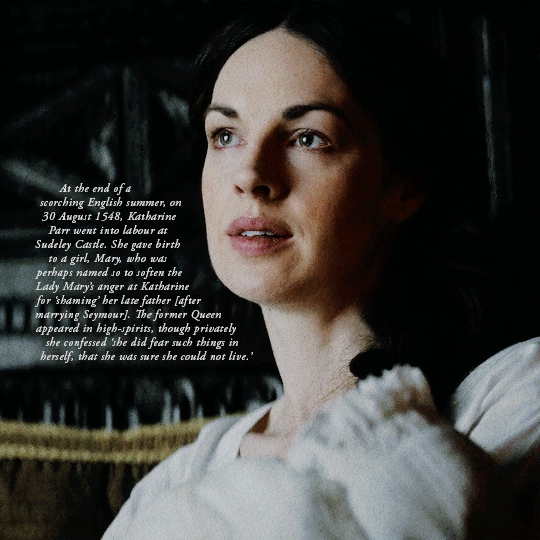
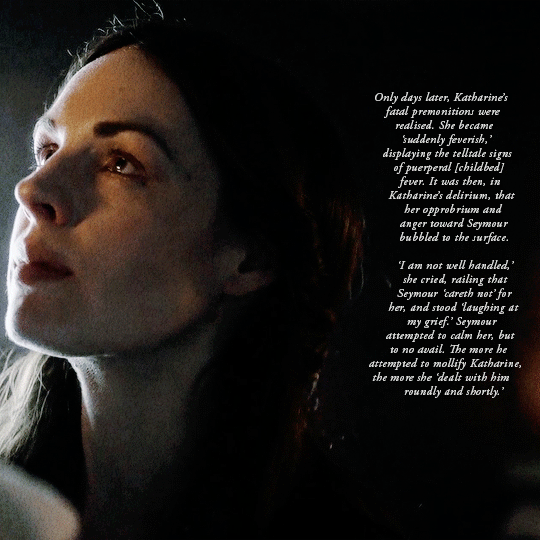
5 September 1548: Death of Queen Katharine Parr.
‘The former Queen died in the early hours of 5 September, harrowed with anguish and humiliation. She was interred on the same day in a chapel on the grounds of Sudeley Castle, with bizarre haste, deprived of the time-honoured rituals befitting a woman who had once been Queen of England. Katharine was not afforded a funeral effigy, nor a procession of mourners, nor did she lie-in-state, surrounded by thousands of wax candles, as her predecessors Catherine of Aragon and Jane Seymour had done. Her sole legacy to the world, Mary Seymour, passed into the hands of a noblewoman, [Katharine Willoughby, Duchess of Suffolk], and most likely died in infancy.’ D. Novakovic, The Dramatic Afterlife of Katharine Parr.
#katherine parr#catherine parr#the tudors#perioddramaedit#historyedit#perioddramacentral#becoming elizabeth#mary i#elizabeth i#jessica raine#becomingelizabethedit#tvedit#perioddramagif#**#my beloved
256 notes
·
View notes